Sustainable Electronics Manufacturing Market Size and Trends
Global sustainable electronics manufacturing market is estimated to be valued at USD 15.33 billion in 2025 and is expected to reach USD 68.35 billion by 2032, exhibiting a compound annual growth rate (CAGR) of 23.8% from 2025 to 2032.
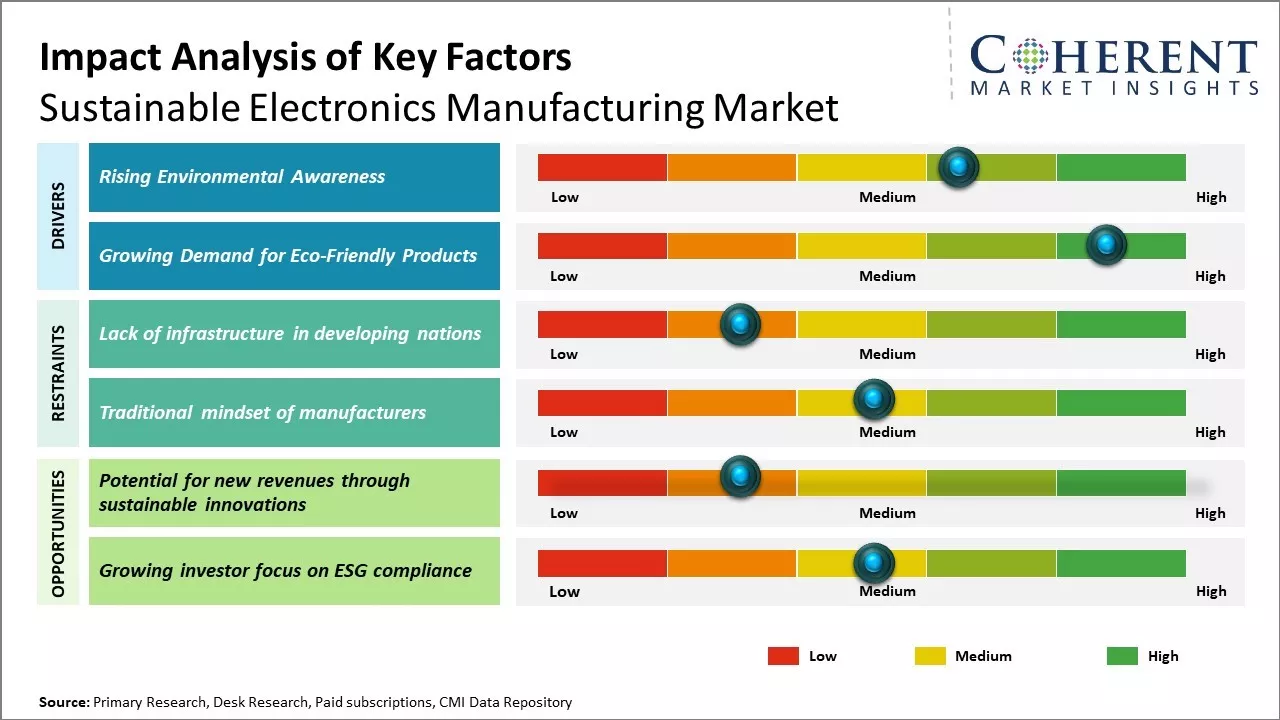
Discover market dynamics shaping the industry: Download Free Sample
The market growth is driven by increasing awareness about environmental protection due to the vast amounts of electronic waste. Electronics manufacturers are focusing on reducing the carbon footprint and adopting renewable energy sources to manufacture devices in a sustainable way. Numerous countries now have rules to reduce e-waste, pushing electronics companies to build sustainability into their products from the start of the design and manufacturing process. New technologies around recycling and reusing electronic scrap are also fueling the trend of circular economy in the electronics industry. Initiatives involving stakeholders across the value chain from governments to producers are facilitating the transition towards an environment-friendly electronics sector.
Global Sustainable Electronics Manufacturing Market- Drivers
Rising Environmental Awareness
As climate change and environmental problems have become more serious concerns globally, both consumers and businesses are now more conscious of how their actions affect the environment. There is a growing awareness that traditional electronics manufacturing processes, which involve large amounts of hazardous chemicals, heavy metals, carbon emissions and electronic waste, simply cannot continue without serious consequences for the environment. More people now understand the connection between the devices one use every day and issues like pollution, depletion of natural resources, and greenhouse gas emissions over the full product life cycle from raw material extraction to disposal.
Governments and regulatory bodies have slowly begun imposing stricter regulations on electronics manufacturers to curb their environmental footprint and encourage more sustainable practices. Additionally, major tech companies are facing mounting pressure from their customers and shareholders to demonstrate strong commitments to sustainability in their supply chains and operations. As a result, electronics manufacturers can no longer afford to ignore the environmental costs of their businesses. These must clean up their act and transition to greener manufacturing processes if these want to remain competitive and compliant in this new business landscape defined by escalating environmental standards.
Market Concentration and Competitive Landscape
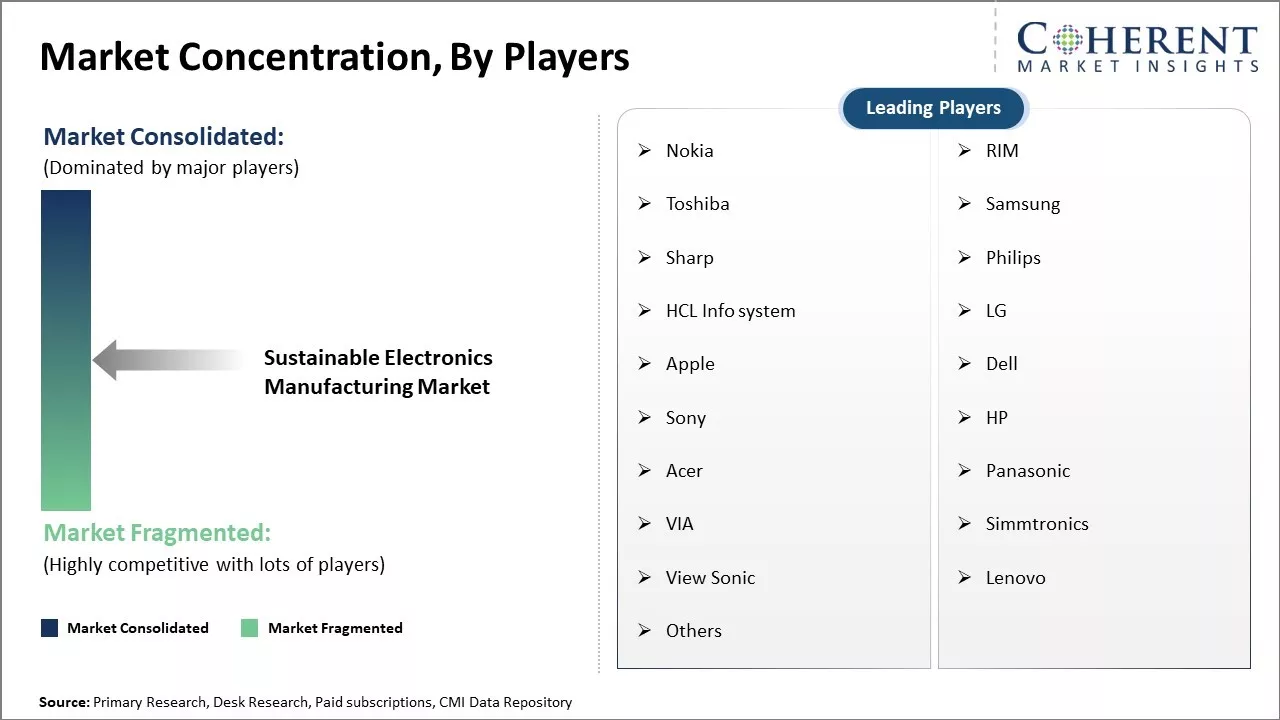
Get actionable strategies to beat competition: Download Free Sample
Growing Demand for Eco-Friendly ProductsAlongside the heightened awareness about environmental issues, consumer demand for sustainable and eco-friendly products has also increased significantly in recent years. More and more customers, especially millennials and Gen Z, actively seek out brands that prioritize minimizing their environmental impact and carefully consider a company's sustainability credentials when making purchase decisions. These people are willing to pay premium prices for products certified as green by external organizations. This consumer shift towards sustainability has compelled major electronics brands to invest heavily in developing greener product lines, using recycled materials, removing toxic chemicals from their devices and improving energy efficiency and repair/reuse to satisfy the ethical purchasing preferences of their client base.
At the same time, large B2B corporations have implemented stringent supplier codes of conduct when it comes to reducing emissions, banning environments-unfriendly substances and maintaining transparency throughout global supply chains. As environmental sustainability emerges as a key competitive differentiator, electronics manufacturers must assure both individual consumers and large corporate customers that their products are manufactured responsibly through disclosure of sustainability efforts and third-party validation. Those who fail to meet evolving industry standards and consumer demands for eco-friendly electronics will struggle to find customers in an increasingly values-driven market.
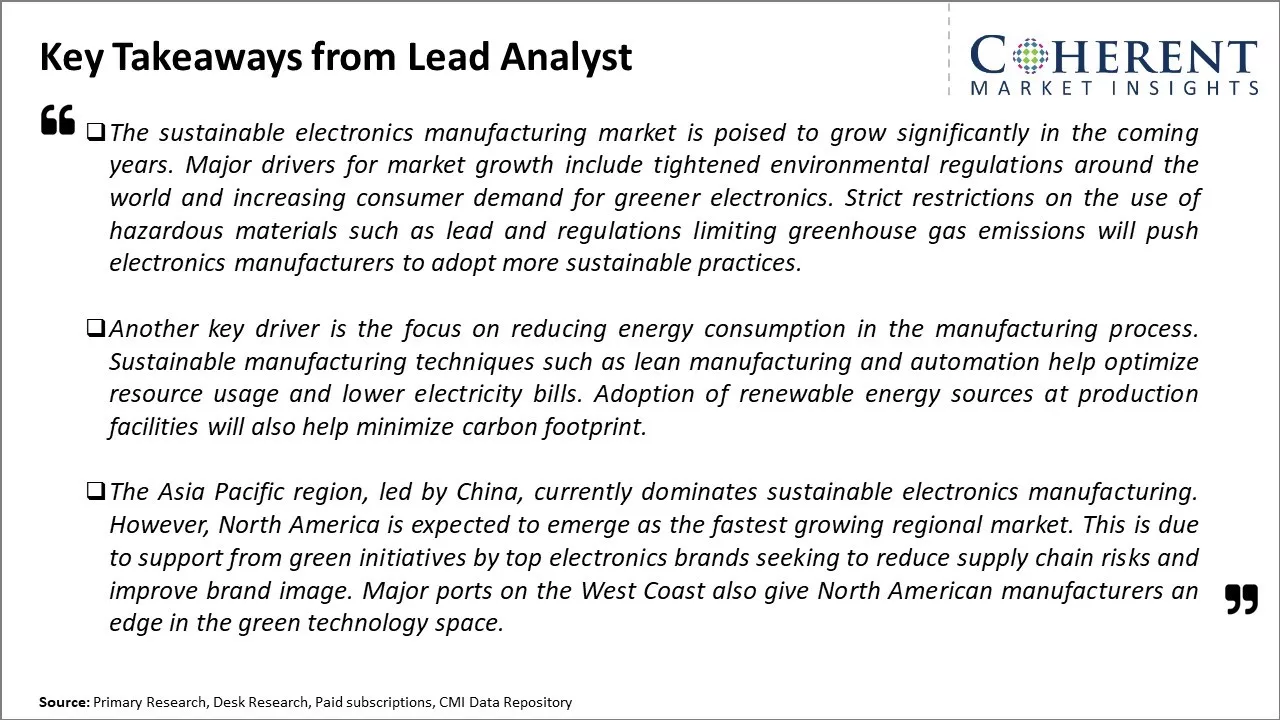
To learn more about this report, Download Free Sample
Sustainable Electronics Manufacturing Market Challenges:Some of the key challenges faced by the sustainable electronics manufacturing market include higher costs of production compared to traditional methods and supply chain difficulties in sourcing certified sustainable materials. Regulations on hazardous substances also add complexity for OEMs in transitioning existing product lines. Many consumers are not very aware of sustainability features, and in developing countries where there's a rising demand for electronics, people still prioritize low initial costs over environmental concerns. Additionally, certifying sustainability claims and measuring overall footprint reductions poses measurement challenges.
Sustainable Electronics Manufacturing Market Opportunities:
However, the market also presents several opportunities. Large corporations have set ambitious sustainability goals and are actively seeking greener supply partners. Premium market segments are willing to pay more for sustainable credentials. Developing recycled and biobased material supply chains can improve energy security while minimizing price volatility. Manufacturers focusing on design for the environment, refurbishing, and resource efficiency stand to gain competitive advantage in both cost savings and brand differentiation.
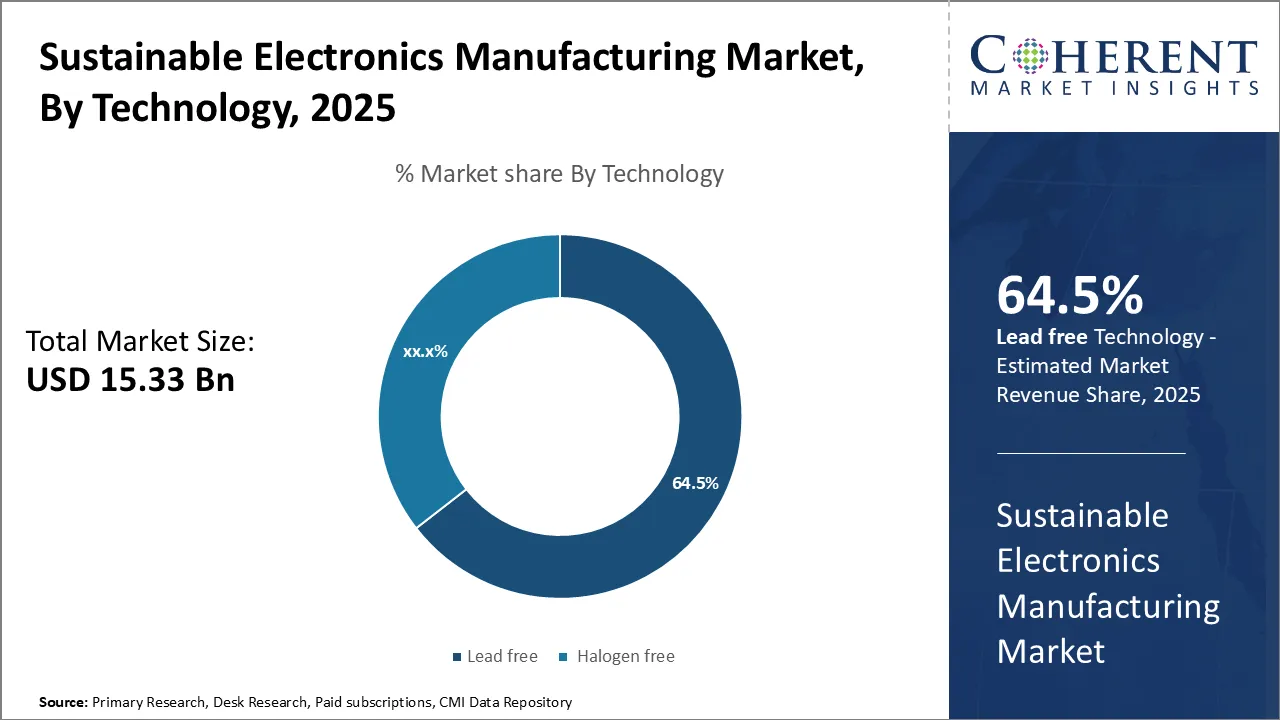
Discover high revenue pocket segments and roadmap to it: Download Free Sample
Insights, By Technology - Rising environmental concerns boosts demand for lead free electronicsIn terms of technology, lead free segment is estimated to contribute the highest share of 64.5% in 2025 of the market owing to growing environmental regulations around the world. Lead has traditionally been used in soldering applications due to its desirable properties like mechanical strength and low melting point. However, lead is a toxic heavy metal that can damage the central nervous system and other vital organs if exposed in large quantities. Rising awareness about the negative health impacts of lead pollution has led many countries to enact stringent rules pertaining to its usage in consumer products.
The Restriction of Hazardous Substances (RoHS) directive passed by the European Union in 2006 was a major milestone that banned the use of lead and other toxic chemicals in electronic goods. This provided a major impetus for electronics manufacturers to shift towards lead-free soldering methods and alloys. Countries like China, India, Japan and South Korea have introduced their own versions of the RoHS directive to regulate heavy metal content in devices. Compliance with such regulations is now a prerequisite for electronics brands to access major global markets.
Lead-free solders offer manufacturers an environment-friendly alternative to traditional lead-tin solders. Tin-silver-copper alloys have emerged as the most popular lead-free substitute owing to superior properties like mechanical fatigue resistance and compatibility with surface mount equipment. Continuous R&D is enabling lead-free solders to match or exceed the performance of lead-based predecessors. This boosts wider acceptance of these green solders, thereby contributing to the lead-free segment's large market share.
Insights, By Service - Increased demand for specialized electronic manufacturing services is being fueled by growth in complex electronics.
In terms of service, electronics manufacturing services segment is estimated to contribute the highest share of 37.5% in 2025 of the market. However, the manufacturing of advanced chips, boards and systems has become highly complex due to miniaturization, greater functional integration and stringent quality controls. Cutting-edge manufacturing demands specialized infrastructure and skillsets that are beyond the core competencies of many OEMs. This has created opportunities for dedicated electronics manufacturing services (EMS) providers to support OEMs through their vast expertise.
EMS players leverage scale economies to make capital-intensive manufacturing facilities and cleanroom environments accessible to OEMs. These also employ highly trained engineers skilled in areas such as surface mount technology, optical and x-ray inspection, and reliability testing. This enables EMS vendors to complement OEMs' design capabilities with superior production know-how. As electronics move toward the bleeding edge, OEMs now increasingly outsource mature product lines to EMS specialists and focus internal resources on innovation.
Emerging technologies like 5G, AI/ML, IoT and EV are driving new design paradigms with stringent yield, quality and reliability obligations. Fulfilling the stringent manufacturing needs of such advanced solutions necessitates specialized services from EMS providers with track records of success in similar high-tech domains. This dependence on EMS expertise to navigate today's treacherous manufacturing terrain contributes significantly to its large market share.
Insights, By Industry - The IT industry is driving telecom gear manufacturing towards more sustainable practices.
In terms of industry, IT and Telecom segment is estimated to contribute the highest share of 23.5% in 2025 of the market. This can be attributed to the IT industry's growing focus on sustainability best practices across the value chain. Data centers and telecom networks are now recognized as major sources of greenhouse gas emissions due to the massive infrastructure required to power our digital lifestyles. Tech giants are under increasing pressure from regulators, investors and consumers to curb environmental impacts.
Key IT companies have announced bold commitments and reform roadmaps around transitioning to renewable energies, designing greener devices, deploying energy efficient data centers and supply chain decarbonization. Telecom operators are also incentivized to adopt sustainable practices in facilities and gear to reduced operating expenditures through efficiency improvements.
Equipment innovation plays a vital role in enabling service providers to deliver hyper connectivity and seamless experiences sustainably. Emerging technologies like 5G, AI/ML and edge computing present both manufacturing challenges and opportunities for 'building in' eco-efficiency right from the design phase. Sustainable electronics manufacturers supporting these strategic technology domains gain prominence due to their acute understanding of their customers' green imperatives. This positions the industry at the forefront of the sustainable electronics manufacturing market.
Regional Insights
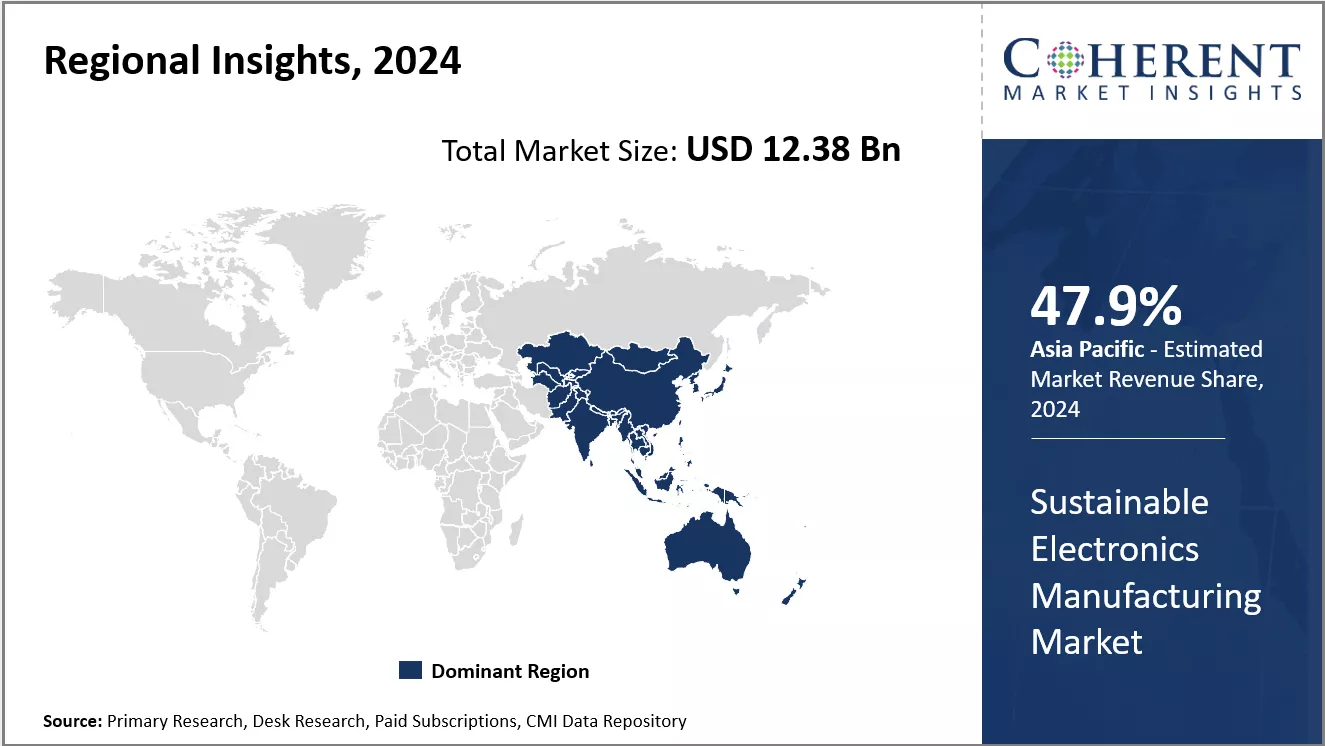
Need a Different Region or Segment? Download Free Sample
Asia Pacific has established itself as the dominant region with 48.4% market share in 2025 in the global sustainable electronics manufacturing market. the region has seen significant investments into building manufacturing facilities that incorporate sustainable practices. Many OEMs and contract manufacturers now focus on reducing the environmental impact of their operations through measures like switching to renewable energy, implementing closed-loop water recycling systems, and optimizing production processes to minimize waste generation.
Government support has also been instrumental in driving the region's leadership. Moreover, regulatory frameworks in the region are progressively mandating greener compliance for electronics products and manufacturing facilities. With some of the world's strictest laws around waste diversion and pollution control, Asia Pacific sets the benchmark for environment-friendly electronics manufacturing globally.
Meanwhile, the Asia Pacific region has emerged as the fastest growing market, led by countries like India, Taiwan and Vietnam. With lower costs of operations compared to mature markets, APAC nations have succeeded in attracting several manufacturing units shifting out of China in recent years. Taiwan, in particular, has strengthened its foothold, supported by initiatives of the government and industrial bodies to promote ecological production. The region also benefits from its skilled talent pool experienced in electronics manufacturing.
South Asian countries, especially those in South Asia, are using their manufacturing skills and competitive advantages to increase their capacity for sustainable manufacturing. For example, India provides incentives for local electronics assembly using recycled materials. . Several global and domestic firms have announced investments into new India-based facilities focusing on green criteria. This is expected to significantly boost the region's share in the coming years, making APAC a frontier for eco-friendly electronics manufacturing worldwide.
Market Report Scope
Sustainable Electronics Manufacturing Market Report Coverage
| Report Coverage | Details | ||
|---|---|---|---|
| Base Year: | 2024 | Market Size in 2025: | USD 15.33 Bn |
| Historical Data for: | 2020 To 2024 | Forecast Period: | 2025 To 2032 |
| Forecast Period 2025 to 2032 CAGR: | 23.8% | 2032 Value Projection: | USD 68.35 Bn |
| Geographies covered: |
|
||
| Segments covered: |
|
||
| Companies covered: |
Nokia, RIM, Toshiba, Samsung, Sharp, Philips, HCL Info system, LG, Apple, Dell, Sony, HP, Acer, Panasonic, VIA, Simmtronics, View Sonic, Lenovo, Others |
||
| Growth Drivers: |
|
||
| Restraints & Challenges: |
|
||
Uncover macros and micros vetted on 75+ parameters: Get instant access to report
Market Segmentation
- Technology Insights (Revenue, USD BN, 2020 - 2032)
- Lead free
- Halogen free
- Service Insights (Revenue, USD BN, 2020 - 2032)
- Electronics Manufacturing Services
- Engineering Services
- Test & Development Implementation
- Logistics Services
- Others
- Industry Insights (Revenue, USD BN, 2020 - 2032)
- Consumer Electronics
- Automotive
- Heavy Industrial Manufacturing
- Aerospace and Defense
- Healthcare
- IT and Telecom
- Others
- Regional Insights (Revenue, USD BN, 2020 - 2032)
- North America
- U.S.
- Canada
- Latin America
- Brazil
- Argentina
- Mexico
- Rest of Latin America
- Europe
- Germany
- U.K.
- France
- Italy
- Russia
- Rest of Europe
- Asia Pacific
- China
- India
- Japan
- Australia
- South Korea
- ASEAN
- Rest of Asia Pacific
- Middle East & Africa
- GCC Countries
- South Africa
- Rest of Middle East & Africa
- North America
- Key Players Insights
- Nokia
- RIM
- Toshiba
- Samsung
- Sharp
- Philips
- HCL Info system
- LG
- Apple
- Dell
- Sony
- HP
- Acer
- Panasonic
- VIA
- Simmtronics
- View Sonic
- Lenovo
- Others
Share
Share
About Author
Raj Shah is a seasoned strategy professional with global experience, from strategy to on-the-ground operational improvements. In last 13 years, he has executed number consulting projects focused on consumer electronics, telecom and consumer-internet business leading multiple long-term engagements towards mobilizing and executing on break-through strategy - leading to tangible sales results. Raj is also acting as a strategy consultant for one of the leading online hyper local service providers in India, contributing to their growth through critical strategic decisions. Raj usually spends time after office in talking to the passionate entrepreneurs, regardless of their funding status.
Missing comfort of reading report in your local language? Find your preferred language :
Transform your Strategy with Exclusive Trending Reports :
Frequently Asked Questions
EXISTING CLIENTELE
Joining thousands of companies around the world committed to making the Excellent Business Solutions.
View All Our Clients
